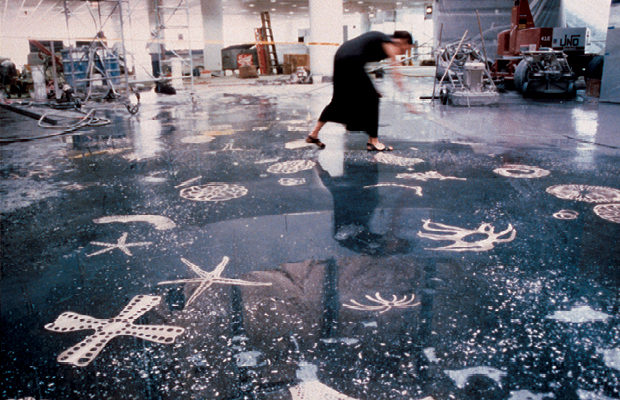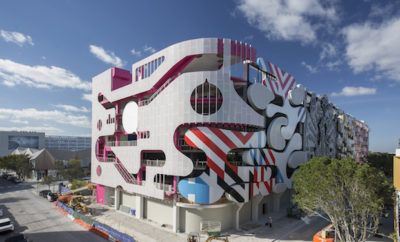 LEA NICKLESS PHOTO
LEA NICKLESS PHOTO
Feature
Heaven & Earth
AT THE BEGINNING OF THE SCHOOL YEAR 1957–1958, I remember gathering maple, oak, and elm leaves and ironing them between sheets of wax paper. That winter we scooped snowflakes from the windowsill onto the glass slides of a microscope. In the spring, dressed in leotards, ribbons, and sandwich boards, we portrayed the planets orbiting the sun. It was the International Geophysical Year [IGY], a pause in hostilities during the Cold War, and a time to think about the family of nature, the family of scientists in the East and the West, and the taxonomic relationships that keep things in order.
Michele Oka Doner has often talked about how IGY “lit her fire” when she was in middle school. To this day, you can see the legacy of her school notebooks with their painstaking drawings of the mysterious forces in the oceans and solar system: it’s there in her letterpress book What Is White, where an ice particle is devised from the impression of wax cuts she made in her studio—“so embryonic,” as she puts it; or in her Celestial chairs with their arcs, swirls, and spirals approximating aurora patterns. IGY oriented her toward self-curated collections: shells and stones found on the beach and organized in rows like little friends, or her white stoneware raku Seeds and Pods spread evenly within an invisible square. No doubt, that engagement also led her to immense public projects, such as A Walk on the Beach at Miami International Airport; or Celestial Objects, first embedded at the entranceway of the Hayden Planetarium and now installed high on the walls of the Rose Center for Earth and Space at the American Museum of Natural History in New York; or, more recently, the sets and costumes for the Miami City Ballet’s Midsummer Night’s Dream, which she reimagined in “the mysterium” of the ocean with its coral and kelp and turtle grass.
Oka Doner, of course, is an artist, not a scientist. While nature is her subject to collect, visualize, depict, and replicate, her art is filtered through imagination and experience: the fragrant mangos ripening, falling, and rotting in her Miami backyard while she was growing up; her mother with frangipani tucked behind her ear; her father, a mayor of Miami Beach and a judge; college and graduate school in the political cauldron and artistic mélange of Ann Arbor in the 1960s; and the soulful artistic cultural institutions of Detroit in the ’70s. It’s the mixture of these particulars plus extraordinary design intelligence, huge energy, and, I suspect, a heaping dose of obsessiveness that make her work exceptional.
Not long ago I visited Oka Doner at her remarkable New York SoHo loft, which occupies the entire second floor of a historic cast-iron building and where she lives with her husband, Frederick Doner, and raised their two now grown sons. The studio is a vast and elegant space with sixteen-foot ceilings, a wall of double-height windows, fluted neoclassical cast-iron columns encircled by white-painted radiators, and an upper mezzanine from which you can look down on an abundance of chairs, benches, and tables, including pieces by Carlo Bugatti and an ultramodern table that was a fiftieth birthday present from her friend, collector Mitchell Wolfson Jr. Everything in the open area has been introduced with intentionality, positioned with the same balance and asymmetrical symmetry as the stars and space matter that seem to float across Celestial Objects. And it is equally true of the ubiquitous smaller objects the artist has collected, molded, sculpted, carved, or gilded throughout her career—it was a pleasure to see so many of her signature pieces in their natural habitat.
Almost three hundred of Oka Doner’s porcelain Soul Catchers are mounted as sentries on the curving wall of the entranceway. She began making these anthropomorphic forms in the late 1970s and returned to them during her 2008–2010 residency at the historic Nymphenburg Porcelain Manufactory in Germany, creating fifteen hundred more. If you look at the figures carefully, you see how similar they are to naturally holed beach stones; but, with twisted, gouged, pocked, and abraded surfaces and ranging in size from two to ten inches long, they seem also to be votive figures, skeletal heads, skulls with chins, skulls with necks, heads on spikes, members of a prehistoric family, souls of the dead casting their spells.
“You’re coming into my cave,” the artist warns teasingly, then continues, “and this is a cave. The space is only differentiated by use, not by walls.” Once inside, your eyes go immediately to a huge ink drawing, a study for an architectural dome in Doha, based on a photograph of mother-of-pearl seen under a microscope. The undulating, mosaic-like pattern could be the depiction of geologic terrain, the surface of a piece of granite or basalt, the body of a sponge resting on a seabed, or a thousand other things. That instability of potential is a theme that runs throughout Oka Doner’s work. She’s constantly pointing out how objects found in nature—fossils or stones, for instance—resemble a human hand or a heart or a footprint.
A cabinet inset in a wall displays one of her armless Tattooed Dolls, part of an early series inspired by the pricked surfaces and torso shapes of coral. This one has the serene face of a child Buddha and sits flat without a pedestal, legs spread apart like a baby doll. From the outset, Oka Doner’s figurative pieces were prompted by the collecting she did as a child and they retain the look of organic materials worn down, broken, and drifted up on the shore. This is also the case with a group of striped, armless (and sometimes headless) figures with staffs, all of them banded like zebra-striped shells. But their broken-off leg stumps suggest a narrative; you wonder if they’ve been wounded or violated or if, perhaps, they came into the world incompletely complete. Amulets, masks, artifacts, arrowheads, odds and ends from the artist’s foundry are lined up like grave offerings in front of the ceramic figures, an extension of the play between anthropology and artistry, collecting and making.
Toward the center of the room, a Burning Bush candelabra rests on the lid of a grand piano like a bundle of branches or tumbleweed. A cast-bronze Radiant table supports a variety of design objects inspired by the ocean and its detritus—three of Oka Doner’s hand-blown and etched crystal bowls set on bronze and cast-glass reefs and a wax sculpture of a brain that, she says, “emulates or suggests brain coral” beneath a glass dome. A cast-glass Radiant plate holds tropical seeds and foraged materials arranged and loosely organized across quadrants.
Oka Doner is a gracious hostess and you can tell immediately she’s both intrepid and slightly shy. As a bell-bottomed student at the University of Michigan, she appeared in an experimental film directed by George Manupelli, one of her professors, and over the years she’s been photographed by such stars as Robert Maxwell, whose 2005 portrait of her modeling a sculptural necklace with her breasts half exposed appeared in the New York Times Magazine. Now she’s a fashionable grandmother, known for wearing custom-made tunics with draped necklines and leggings. Consistently, her design work has focused on a desire to re-dignify daily life by instilling an awareness of ritual. She’s interested, for instance, in the meaning of sitting on a chair—the privilege of elevation. The bronze and silver Celestial and Coral Wave chairs draw attention to themselves, to their hard essence, when they’re used, but they also have a kinship to objects of ceremony because of the swirling, glittering symbols of sky and sea that are part of their surfaces.
On the day I visited, Oka Doner showed me her Poetry Carts—bookshelves on wheels she’s made from wood and cast and fabricated bronze. We sat together on a Citra bench, a giant slab of tropical almond wood that positioned us at precisely the right distance from the books and from one another. She showed me a beautiful early volume by the poet Cid Corman, who spent most of his working life in Japan: “Gorgeous cover, flocking, burlap,” she said. Then we looked through some books she’s made by hand—she calls the small ones “poetry books,” and I would agree, though I’d say they are “concrete poetry” or perhaps “collage poetry” since they contain found and salvaged objects and works on paper.
Her Palm Books, produced in varying dimensions on abaca paper, are little meditations on design in nature, each page showing a different configuration of the palm leaf, crisscrossed or fanning open like a star—reminding us of the connections between the terrestrial and the celestial. Some of her books are constructed accordion style and others have transparent pages that are meant to be read in overlapping sequence. Several contain a mixture of organic and inorganic materials: sandpaper, fragments of an old polaroid photograph, rubbings from a Roman button found in Spain, a vacuum cleaner filter, fabric from a family couch, tests for different paint colors, and bark and root scraps left over from a recent work on paper. “Process,” she says, and follows up the thought: “I go through drawers and find moments, curating and cropping them, finding materials.”
One of the found objects, a scrap of punched metal, reminded me of the bronze and silver often associated with her work but seemingly at odds with her interest in the natural world. It made me think of Miami glamour and the luxurious invented Eden of her childhood. (She and her friend Wolfson, both of them children of former Miami Beach mayors, wrote a book about that era in Miami, part nostalgia and part artistic memento.)
I asked how she felt about that glamour today. She paused and her answer took us back to the postwar period, that gray time during the Cold War: “My mother was glamorous. I loved it. It was uplifting. It was exciting . . . . But you have to look at things in their time, in their context. Fifty years ago, to endow objects with larger meaning, even ceremonial meaning, I often used metals. I wouldn’t make things the same today. There’s so much bling.” Thoughtfully, she added, “I only gild things when they need light. You know, they’re just too dark and I can’t undo the dark.”
Light, of course, is what Miami glamour was about. It’s what made the lush vegetation thrive and drew crowds to the cleared-away brush and to the beaches. It’s interesting to think how a deep understanding of light is at the core of Oka Doner’s work, particularly her first major public project, the 1990 Radiant Site in New York’s Herald Square subway station, where she covered a passageway floor-to- ceiling with eleven thousand gold luster tiles glazed and fired at the Pewabic pottery in Detroit. “You know, I was thinking about the Ravenna mosaics, the way they illuminate space” she told me. “But I was also thinking of other places, too, where there’s mud and dirt and human misery. In Mexico they have the San Cayetano Church, where there’s so much ornate gold and that luster enhances the spirituality of the building and perhaps adds comfort for those who gather there.”
The same sensitivity to light was the wellspring of her design for the Miami City Ballet’s underwater–themed Midsummer Night’s Dream. And light streams through her sculpture Totem, built from archival wax and organic materials between 2007 and 2015. Totem is a heroic piece, rising like a grand tree trunk laced with vines and, at the same time, suggesting the abstracted form of an ancient caryatid and reminding us of beauty’s perishability. Oka Doner explained her choice of the unusual material to me: “When you cast in bronze you lose a lot of light. Actually, it gets dark. And I didn’t want that piece to be dark. That’s white, archival wax compressed with a tool, compressed over and over again, so it’s burnished and the molecular level is very tight.” And it’s true, light bounces all over the fissures and crevices of the piece. It gets caught in the tangles and moves across the dense surfaces as if they were drapery—the luster is always changing.
We talked about the way different materials carry light, how a necklace brings light to a woman’s face, for instance. “It’s a female instinct,” she said, adding, “I was in Israel once and we went to see some caves in the hills near Haifa. There were burials in that Natufian culture. There was the burial of a woman, more than ten thousand years old, and the skeleton had pearls around her neck. They were from the mussels—they had been collected from the mussels they ate . . . and at the base of the grave, microscopic pollen grains as well as impressions of flowering plants indicate she had been buried with flowers . . . flowers and a small amount of ornamentation. You know these things are in our DNA.” The memory brought together many strands of her life in art: her interest in the connectivity of nature, human ritual, adornment, illumination, and science, of course—the aurora forms and arcs of light that were her starting point.












